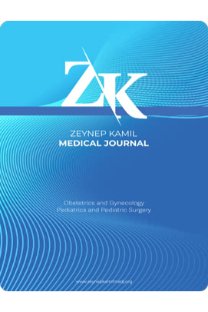Laparoskopik Tubal Reanostomozda Gebelik Oranları: 2. Basamak Merkezin Deneyimleri
Pregnancy Rates in Laparoscopic Tubal Reanostomosis: Experiences of Second Stage Center
___
- 1- Daniels K, Daugherty J, Jones J, Mosher W. Current Contraceptive Use and Variation by Selected Characteristics Among Women Aged 15-44: United States, 2011-2013. Natl Health Stat Report. 2015;(86):1-14.
- 2- Gordts S, Campo R, Puttemans P, Gordts S. Clinical factors determining pregnancy outcome after microsurgical tubal reanastomosis. Fertil Steril. 2009;92(4):1198-202.
- 3- Liskin L, Rinehart W, Blackburn R, Rutledge AH. Minilaparotomy and laparoscopy: safe, effective, and widely used. Popul Rep C. 1985;(9):C125-67.
- 4- Trussell J, Guilbert E, Hedley A. Sterilization failure, sterilization reversal, and pregnancy after sterilization reversal in Quebec. Obstet Gynecol. 2003;101(4):677-84.
- 5- Gomel V, McComb PF. Microsurgery for tubal infertility. J Reprod Med. 2006;51(3):177-84.
- 6- Berger GS, Thorp JM Jr, Weaver MA. Effectiveness of bilateral tubotubal anastomosis in a large outpatient population. Hum Reprod. 2016;31(5):1120-5.
- 7- Van Seeters JAH, Chua SJ, Mol BWJ, Koks CAM. Tubal anastomosis after previous sterilization: a systematic review. Hum Reprod Update. 2017;23(3):358-370.
- 8- Malacova E, Kemp-Casey A, Bremner A, Hart R, Stewart LM, Preen DB. Live delivery outcome after tubal sterilization reversal: a population-based study. Fertil Steril. 2015;104(4):921- 926
- 9- Sreshthaputra O, Sreshthaputra RA, Vutyavanich T. Factors affecting pregnancy rates after microsurgical reversal of tubal sterilization. J Reconstr Microsurg. 2013;29(3):189-94.
- 10- Ribeiro SC, Tormena RA, Giribela CG, Izzo CR, Santos NC, Pinotti JA. Laparoscopic tubal anastomosis. Int J Gynaecol Obstet. 2004;84(2):142-6.
- 11- Yoon TK, Sung HR, Kang HG, Cha SH, Lee CN, Cha KY. Laparoscopic tubal anastomosis: fertility outcome in 202 cases. Fertil Steril. 1999;72(6):1121-6.
- 12- Rouzi AA, Mackinnon M, McComb PF. Predictors of success of reversal of sterilization. Fertil Steril. 1995;64(1):29-36.
- 13- Dubuisson JB, Chapron C. Single suture laparoscopic tubal re-anastomosis. Curr Opin Obstet Gynecol. 1998;10(4):307- 13.
- 14- Bissonnette F, Lapensée L, Bouzayen R. Outpatient laparoscopic tubal anastomosis and subsequent fertility. Fertil Steril. 1999;72(3):549-52.
- 15- Ribeiro SC, Tormena RA, Giribela CG, Izzo CR, Santos NC, Pinotti JA. Laparoscopic tubal anastomosis. Int J Gynaecol Obstet. 2004;84(2):142-6.
- 16- Yoon TK, Sung HR, Cha SH, Lee CN, Cha KY. Fertility outcome after laparoscopic microsurgical tubal anastomosis. Fertil Steril. 1997;67(1):18-22.
- ISSN: 1300-7971
- Yayın Aralığı: 4
- Başlangıç: 1969
- Yayıncı: Ali Cangül
Ayşen BOZA, Ece AKSAKAL, Mehmet CEYHAN, Oğuzhan BULDUK, Başak BALABAN, Bülent URMAN
Orhan UZUN, İbrahim Ali ÖZDEMİR, Hakan BAYSAL, Fatih BÜYÜKER
Ergen kızlarda polikistik over sendromu: klinik, endokrin ve metabolik bulgular
Bahar ÖZCABI, Feride Tahmiscioğlu BUCAK, Esma ŞENGENÇ, Evrim SUNAMAK, İbrahim ADALETLİ, Sebuh KURUOĞLU, Oya ERCAN, Olcay EVLİYAOĞLU
Tiroid Kanserleri: Tanı ve Cerrahi Tedavisi
Abdülhak Hamit KARAYAĞIZ, Ekrem FERLENGEZ
Yakup KUMTEPE, Emsal Pinar Topdagi YILMAZ, Yunus Emre TOPDAGI, Seray Kaya TOPDAGI
Uterus Didelfis Olgusunda Dikaviter İkiz Gebelik
Necip Cihangir YILANLIOĞLU, Koray ÖZBAY, Resul ARISOY, Semra KAHRAMAN
Çocuk Yoğun Bakım Ünitesinde Yatan Hastaların Retrospektif Değerlendirilmesi
Merve KİŞİOĞLU, Derya BÜYÜKKAYHAN, Muhterem DUYU
Yunus Emre TOPDAĞI, Emsal Pinar TOPDAGİ YİLMAZ, Seray KAYA TOPDAGİ, Yakup KUMTEPE
